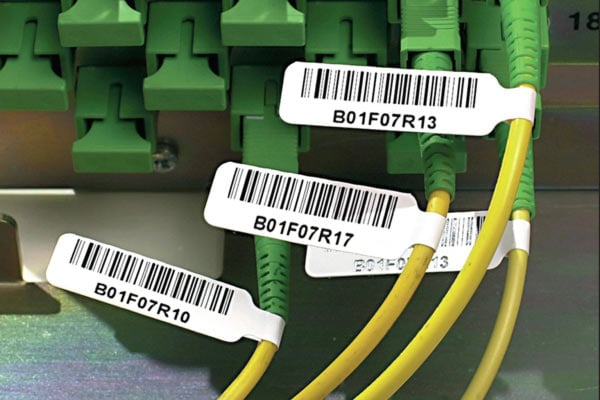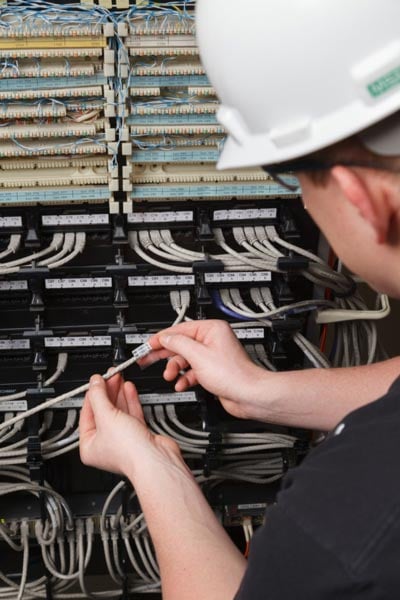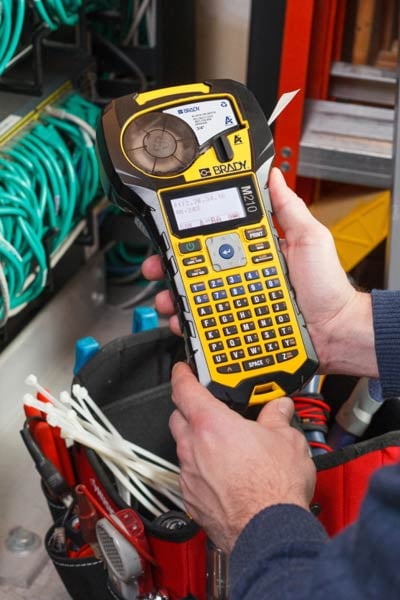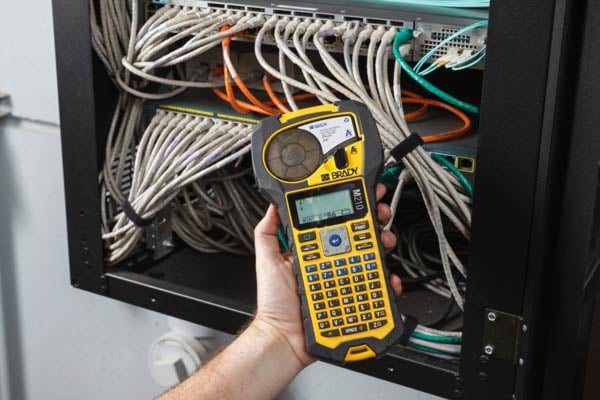TIA-568: The Foundation of a Reliable Data Center
Structured cabling is essential in data centers, ensuring reliable, scalable and efficient communication networks. It supports high-speed data transmission, reduces downtime and simplifies maintenance. Industry standards like TIA-568 from the Telecommunications Industry Association (TIA)(opens in a new tab) define guidelines for cable types, performance and installation practices. Specifically, TIA-568 ensures interoperability between equipment, enhances system performance and promotes long-term flexibility, making it a cornerstone for modern, future-proof data center infrastructure.

Key components of the TIA-568 standard
Ethernet cables are categorized by performance.
- Cat5e supports speeds up to one gigabits per second (Gbps) over 100 meters
- Cat6 handles 10 Gbps over 55 meters with better noise reduction
- Cat6A extends 10 Gbps to 100 meters
- Cat8 supports 40 Gbps over 30 meters, ideal for data centers
Fiber optic cables offer faster speeds and longer distances. Single-mode fiber transmits over kilometers, suited for long-haul connections. Multi-mode fiber supports shorter distances (up to 550 meters) with lower cost, ideal for internal data center links. Both provide high bandwidth and minimal signal loss.
Connectors and termination
Choosing the right connectors and using proper termination techniques are integral for maintaining network reliability and performance. TIA-568 standards define connector types, like RJ45 for copper and lucent connector (LC) or subscriber connector (SC) for fiber, ensuring compatibility and minimizing signal loss.
Proper cable termination — including precise stripping, alignment and crimping — prevents issues like crosstalk, signal degradation and downtime. High-quality terminations ensure strong, stable connections, supporting faster data transmission and long-term network stability, which is essential for data centers and enterprise networks.
Cabling topologies
Structured cabling architectures include centralized, distributed and hybrid designs — each suited for different data center needs. Centralized architecture connects all equipment to a main distribution area. This simplifies management but increases cable lengths. Distributed architecture places switches closer to equipment, reducing latency and cable bulk, which is ideal for large, high-density setups.
Hybrid architecture combines both, offering flexibility and scalability. Choosing an architecture depends on factors like data center size, growth plans and performance needs. The right topology ensures efficient data flow, easier maintenance and future-proofing for evolving technologies.
Testing and certification
Comprehensive testing verifies that structured cabling systems meet TIA-568 standards for performance and reliability. Tests like wire mapping, insertion loss, crosstalk and return loss confirm proper installation, signal integrity and compliance with speed and bandwidth requirements.
Identifying issues early — like misfires, poor terminations or signal degradation — prevents costly downtime and ensures the network supports high-speed data transmission. Certified testing supports consistency, maximizes uptime and guarantees that the infrastructure is ready for future upgrades, making it an integral step in data center deployment and maintenance.
TIA-568 versus other standards
TIA-568 and ISO/IEC 11801 are key structured cabling standards that ensure performance and compatibility. TIA-568, mainly used in North America, defines cable types, performance and installation guidelines for commercial networks. ISO/IEC 11801, an international standard, covers similar principles but supports a broader range of environments, including offices, industrial spaces and data centers worldwide.
Both safeguard reliable, high-speed connections and future scalability. While they share similarities, global businesses often follow ISO/IEC 11801 for international consistency, while TIA-568 remains the standard for U.S.-based infrastructure.

TIA-568 revisions and evolution
The TIA-568 standard has evolved through multiple revisions to keep pace with advancing network technologies. Updates address faster speeds, higher bandwidth and new cabling types. These improvements ensure modern networks remain reliable, efficient and future-proof. Staying current with these revisions is crucial for maintaining performance and supporting emerging technologies in data centers and commercial infrastructures.
TIA-568-A versus TIA-568-B
TIA-568-A and TIA-568-B mainly differ in how they assign wire pairs to RJ45 connectors. Both use the same eight wires, but they swap the green and orange pairs. TIA-568-B places the orange pair on pins one and two, while TIA-568-A uses the green pair.
TIA-568-B has become more common because it aligns with older, widely adopted commercial cabling systems, simplifying upgrades and ensuring compatibility — especially in the U.S. Today, it’s the default for most installations, though both standards function identically when consistent throughout a network.
TIA-568-C and beyond
TIA-568-C introduced significant enhancements, including support for higher-performing twisted-pair cables like Category 6A, which accommodates 10 Gbps data rates, and refined guidelines for optical fiber systems. The current revision, TIA-568-E, continues this progression by updating nomenclature, correcting known errors and incorporating technological advancements to maintain alignment with evolving industry needs.
Anticipated future trends in structured cabling standards include accommodating emerging technologies such as 5G networks, Internet of Things (IoT) devices and Power over Ethernet (PoE) applications. These technologies necessitate higher bandwidth capabilities and enhanced power delivery through cabling infrastructures.

TIA-568's importance in data centers
For data centers, the benefits of following the TIA-658 standard include:
- Reliability and uptime: Ensures consistent, high-quality connections, reducing signal loss, crosstalk and downtime.
- Performance and bandwidth: Supports high-speed data transmission and emerging technologies, ensuring networks handle increasing traffic demands.
- Scalability and future-proofing: Accommodates upgrades, new equipment and evolving standards without extensive re-cabling.
- Maintainability: Simplifies cable management, troubleshooting and repairs with standardized layouts, reducing maintenance time and costs.
Following TIA-568 ensures networks are robust, efficient and ready for future advancements — essential for data centers and enterprise environments.

Best practices for implementing TIA-568 in data centers
Strategic planning is vital before installing structured cabling, especially in data centers. Key considerations include cable pathways to avoid congestion, rack layouts for easy access and future scalability to accommodate growth without major rework. Thorough testing — including performance and compliance checks — to ensure reliability and prevent costly issues later. Accurate labeling is also imperative for quick troubleshooting and smooth maintenance. In this way, it’s important to choose the right type of printer. Options include label printers for standard use, industrial label printers for high-volume, durable labeling and portable label printers for on-the-go flexibility. Clear documentation and consistent labeling keep networks organized, saving time and reducing downtime.
How Brady can help
Ensuring TIA-568 compliance requires more than just high-quality cabling — it demands a structured and well-documented approach to cable management. That’s where Brady comes in. As a trusted partner in data center cabling solutions, Brady offers a wide range of products designed to support a compliant infrastructure. From durable, high-performance labeling solutions — including Brady label printers and materials engineered for long-lasting cable identification — to cable management tools like ties and organizers, Brady helps simplify complexity. Where applicable, Brady also provides testing and certification tools to help verify proper installation and performance. For expert advice and tailored solutions that support your cabling infrastructure, contact Brady and take the next step toward a more reliable, compliant data center.
